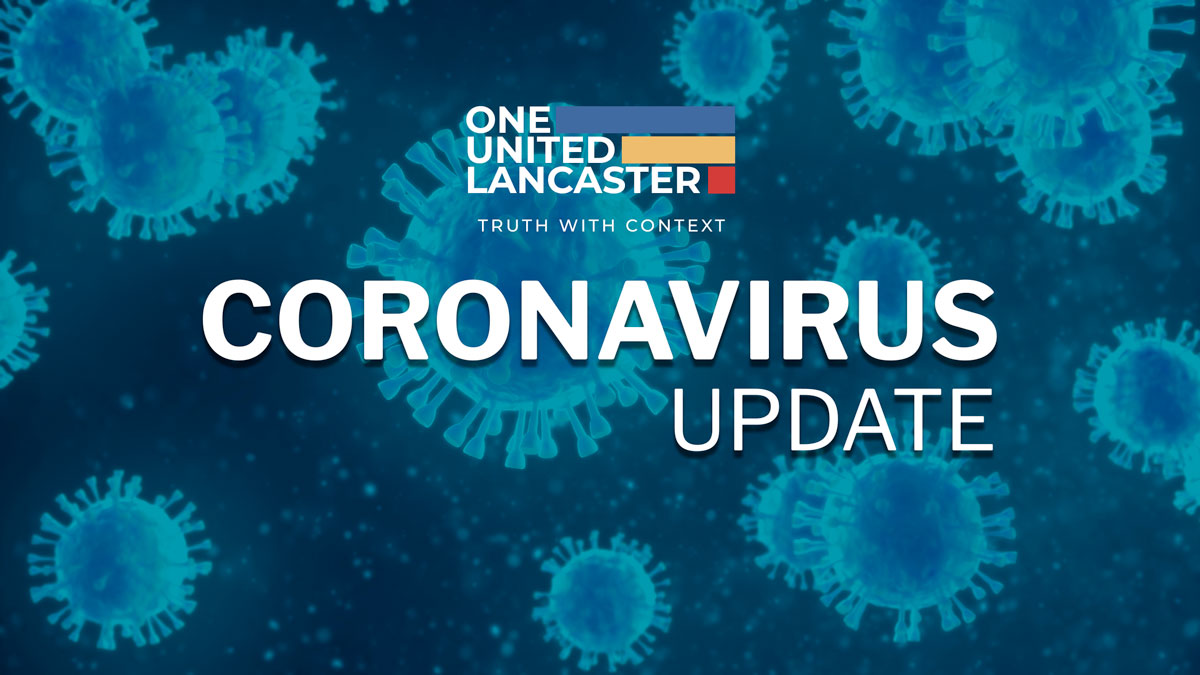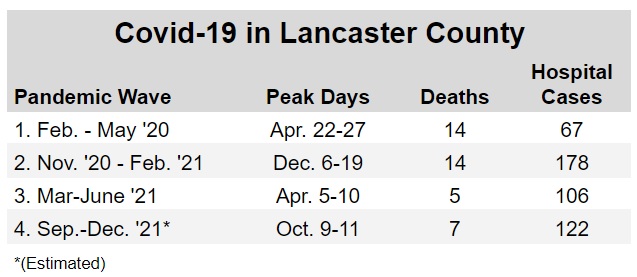
The latest surge of COVID-19 in Lancaster County peaked in mid-October and now, in this first week of November, is steadily receding.
But, through most of the past month, the surge stalled at a high level, hospitalizing and killing more county residents than at any time in the past seven months, when vaccines began to roll out. The details follow.
Deaths
In October, 79 countians died of COVID-19, about five people every two days, according to the office of County Coroner Stephen Diamantoni.
Those deaths continued a four-month trend of rising deaths, from six in July to 18 in August and 51 in September. The October virus deaths were the highest since February, when 90 died here.
As in past months, the virus took its largest toll on those aged 60 and older. Among the 74 victims for whom demographic information was reported:
- 35 were age 80-plus
- 15 were in their 70s
- 11 in their 60s
- 5 in their 50s
- 5 in their 40s
- 2 in their 30s
- 1 in the 20s
- None under age 20
When those deaths are weighed against the number of county residents in each age category, the severity of elderly deaths becomes even more apparent. About 13 people per thousand in the 80-plus age group died, compared to four in the 70s age group, two in the 60s, and less than one per thousand in all other categories.
Hospitalizations
Hospitalizations, second only to deaths as an indicator of the pandemic’s severity, climbed through the first 11 days of October, peaking at 122 cases among all four local hospitals, according to the state Health Department.
Since then, however, the number of COVID-19 patients has trended down, dropping to 107 on Oct. 31. It dropped further to 78 on Nov. 7, about a one-third decline from the peak.
New cases
The number of people testing positive with COVID-19 followed a pattern of rise and fall similar to hospitalizations, but the wave occurred roughly a week earlier.
The current surge began slowly in July, when there was a daily average of 18 new cases, up from 10 in June.
Over the next three months, the daily average rose to 114 in August, 203 in September and 223 in the first half of October. The peak day came Oct. 3 with 334 new cases.
In the second half of October, the number of new cases averaged 180 daily. (In the first seven days of November, the average of new daily cases has dropped further to 162.)
The highest rate of cases occurred in the Bainbridge, Maytown and Mountville ZIP code areas, where about 1.5% to 2% of residents tested positive for COVID. The largest number of new cases occurred in the three Lancaster ZIP code areas (average 483 each), Lititz (438) and Ephrata (367).
Cyclical waves
The pandemic in Lancaster County, like most epidemics anywhere, has followed a cyclical up-down, bell curve pattern. The COVID-19 pattern lasts about three months, rising to a peak over the first six weeks, then subsiding over the next six weeks. We’re now in the four wave.
This chart plots each of the past waves:

If the current wave follows the pattern, the decline that began in late October should bottom out in early December. When the next wave would begin, if there is a next wave, cannot be predicted.
Vaccinations
About 58% of Lancaster County residents, age 10 and above, are vaccinated, the state Health Department says. That’s up from 56% a month ago. But, it should be noted, this month’s report includes a new category of 10- to 14-year-olds that were not included in previous months.
The vaccination rates for the most vulnerable county residents, the elderly, remain exceptionally high – close to 90% of those age 75 and over have been fully vaccinated. For those age 65 to 75, the vaccination rate is almost as high, about 85%.
The vaccination rates for other age groups are:
50-59: 62% | 40-49: 57% | 30-39: 50% | 20-29%: 46%
The state does not make public its data on booster shots.
Data on hospitalization of vaccinated people – so-called breakthrough cases – is limited. In the county, only one hospital – Penn Medicine Lancaster General Health – publishes that information.
For Oct. 31, it reported 60 of its 70 COVID patients were unvaccinated. All 19 patients in the intensive care unit and all 16 on ventilators that day were unvaccinated. That pattern was similar on other days the month.
Nursing homes
Despite high vaccination rates, residents of the county’s 24 nursing homes did not escape the October surge, according to the Centers for Medicare and Medicaid Services.
Eleven residents died of COVID-19 in October, up from four in September. There had been only one death throughout the summer.
Seven of the deaths took place at Fairmount Homes in Ephrata. There was one each at Ephrata Manor, Brethren Village, Landis Homes and Garden Spot Village.
Fifty-nine residents and 98 staff members at nursing homes contracted cases of COVID throughout the month, up from 16 and 51, respectively, in August, before the latest surge began.
Staff vaccination varies widely at county nursing homes, from 33% at the Lancaster Nursing & Rehabilitation Center (formerly Conestoga View) to 88% at Luther Acres.
The percentage of vaccinated residents is consistently much higher, ranging from 80% at Rose City Nursing & Rehabilitation Center to 100% at Brethren Village and The Glen at Willow Valley.
Personal Care Homes
The county’s 41 personal care homes continued to show remarkably low cases and deaths during the latest surge. Only one death occurred among them in October, at Moravian Manor, its first ever and the first at any personal care facility since May.
The homes, which care for the disabled, reported 24 resident and 27 staff cases, up from eight and 12 cases respectively in August.
Child cases
Positive COVID tests among children declined throughout October. At the start of the month (Oct. 6-12), there were 52 cases among children 4 and under. There were 280 cases among children ages 5 to 18.
At the end of the month (Oct. 27-Nov. 2), cases among children 4 and under were cut in half to 26. Cases among the 5 to 18 age group were down 25% to 206.
This summary has been compiled from records of the Lancaster County Coroner’s Office, the state Health Department, the Centers for Medicare & Medicaid Services and the U.S. Department of Health & Human Services by researcher Erica Runkles, sociologist Dr. Mary Glazier, data programmer Penn Glazier and journalist Ernest Schreiber.





